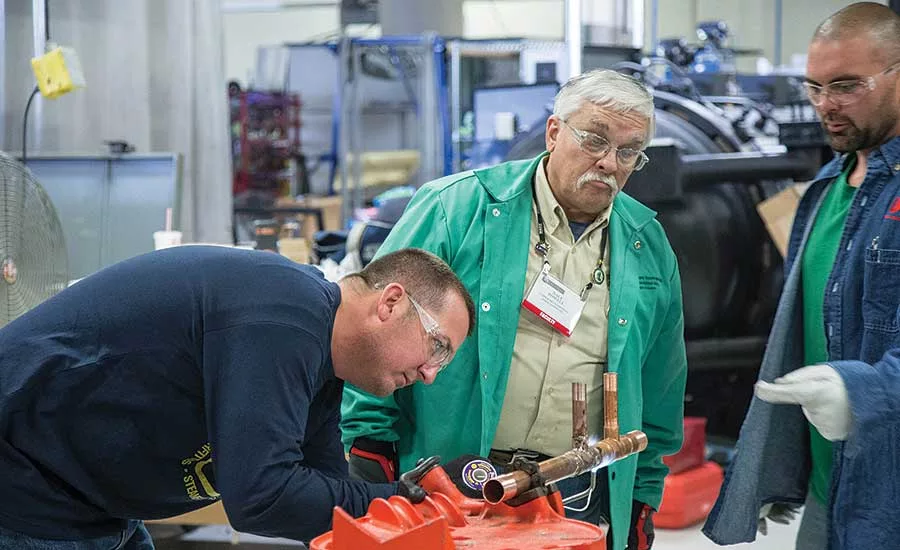Solving the American plumber shortage

Dale Powell, CDA project manager and piping applications specialist, advises plumbing apprentices practicing proper soldering and brazing technique during the UA Instructor Training Program in Ann Arbor, Mich., in August 2017. Photo credit: CDA

Dale Powell is a master plumber and project manager for the Copper Development Association (CDA).
If someone were to ask you, “Who holds more lives in their hands — a doctor or a plumber?” who would you pick? It’s possible the correct answer is the plumber.
Besides fixing annoying drips, skilled plumbers are responsible for providing the clean water we drink. Throughout the past century, human health has taken a dramatic leap forward, thanks in part to plumbers and sanitary engineers who built the infrastructure protecting our drinking water from contamination. So, if plumbers are essential to society, why aren’t millennials interested in the trades?
Today’s young men and women entering the workforce grew up averse to trade careers. Vocational or trade schools are scarce and have developed a negative stigma compared with four-year college or university degrees. Only 3% of 18-to-25-year-olds who have decided on a career path said they would pursue a career in a construction trade, according to a poll conducted by the National Association of Home Builders.
Residential, institutional and commercial structures will always need to be built and repaired, but with more than half of America’s skilled workers nearing retirement age, a plan must be developed to address the insufficient number of millennials entering the trades.
It starts with education
To address the shortage of skilled tradesmen, it is critical that those entering the field are knowledgeable and well-equipped to handle the systems, materials and products of today. Without proper training and education, all types of plumbing and mechanical systems, including water, sewer, HVAC-refrigeration and medical gas piping installations, could potentially break down, experience leaks and create major problems.
It is important to educate and provide proper hands-on-training to those new to the industry as well as instructors with a few years under their tool belt. The Copper Development Association (CDA) regularly sponsors competitions and offers in-person installation and design training to United Association (UA) local unions, Plumbing-Heating-Cooling Contractors Association (PHCC) chapters, merit shop training programs, vocational school programs, contractors and skilled-trades instructors.
Year after year, we have instructors thanking us for our workshops at the annual UA Instructor Training Program. They had been using incorrect soldering and brazing techniques for years because that is how they were taught. Without CDA’s intervention, these incorrect techniques would continue to be passed down. However, with the proper installation techniques, tradesmen can install systems right the first time, more efficiently and with less future repair needs.
Because copper is one of the most widely used materials in piping systems across North America, it is imperative that young and seasoned plumbers are educated about every type of application and are confident that they can tackle tough piping field applications. CDA’s training typically focuses on installation techniques and applications, including: materials selection, soldering and brazing, dissimilar metal joining, alternate no-flame joining, joint analysis, corrosion causes and prevention for long-term performance.
In addition to providing onsite training, CDA has also developed a number of resources for plumbers and technicians working in the field. CDA launched a how-to video series, “Do it Proper with Copper,” which aims to provide the proper installation techniques for various plumbing applications to seasoned and novice professionals. The DIY educational videos are also highlighted within CDA’s Copper Tube Handbook — a mobile, printed and online resource designed to allow plumbers, HVAC technicians and contractors easy access to information about tube, piping and fittings, as well as different joining methods.
Inspiring the next generation of techs
In addition to providing education, it’s important to dispel the negative stigma surrounding the different construction trades. Like many high school graduates of today, Powell packed up his belongings and headed for college. However, four years later, he put aside his white-collar internship and instead began a plumbing apprenticeship.
He knew that one of the most secure jobs in the building construction industry is that of a plumber. There will always be new construction projects or repairs that need to be made. The same cannot be said for all white-collar positions. This statement rings true for millennials as employment opportunities for plumbers, pipefitters and steam fitters are projected to grow 16% from 2016 to 2024, according to the U.S. Bureau of Labor Statistics. Now is the perfect time for millennials to enter the field.
But the question remains, if a career in the trades is stable, reliable and rewarding, how do we attract millennials?
Current professionals in the industry can help boost millennial interest in the trades by showing its massive potential as a career over the coming years. Not to mention, a trade career doesn’t come with massive student loans.
Nearly 40 years after completing his apprenticeship, I am happy that I stepped past the white-collar job pressure and found a career that I’m proud of doing, day in and day out. As a veteran in the plumbing industry, I find tremendous value in giving back and sharing knowledge with the future workforce.
If no one is willing to teach the next generation, there will not be anyone left to do the job.
Looking for a reprint of this article?
From high-res PDFs to custom plaques, order your copy today!









